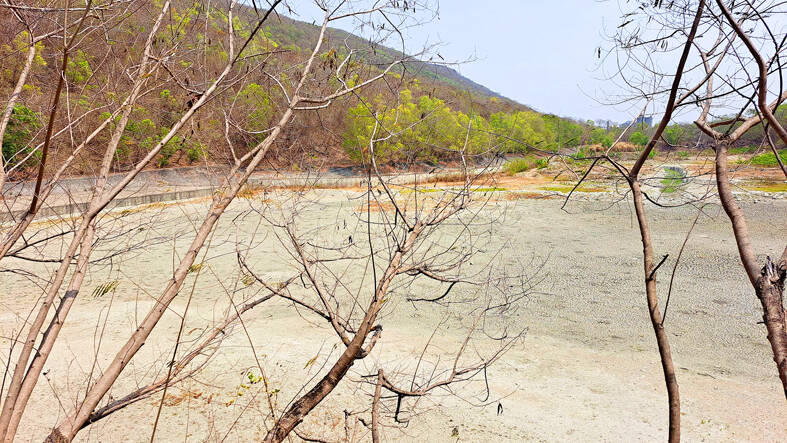The Central Weather Administration (CWA) said it is recalibrating its drought monitoring and early warning system to provide better early warnings to water management and agricultural agencies, after looking at data from three significant droughts Taiwan has experienced since 2000.
Taiwan’s regions are affected by drought differently, data from the National Science and Technology Center for Disaster Reduction’s Climate Change Disaster Risk Assessment Web site showed.
For example, when comparing the ratios of total precipitation between wet and dry seasons across the nation, the disparity is greater in southern Taiwan, so the risk of drought occurring in southern Taiwan is greater than in northern Taiwan.

Photo: CNA
There have been three severe droughts in Taiwan since 2000: one from 2002 to 2004, another from 2015 to 2016, and the last from 2020 to 2021, CWA climate forecasting division head Lo Tzu-ting (羅資婷) said.
Droughts are mainly caused by a lack of precipitation over an extended period, but there could be multiple causes, Lo said, adding that although the three severe droughts affected the whole nation, the severity varied depending on the region.
During the drought between 2020 and 2021, Taiwan had low rainfall due to strong North Pacific High pressure anomalies brought by La Nina. There were no typhoons during that period and the drought was more severe in central and southern Taiwan, Lo said.
Meanwhile, the severe drought from 2002 to 2004, which was not influenced by La Nina, was more serious in central and northern Taiwan, she said.
Rainfall across different regions was relatively low from October 2001 to June 2002, CWA data showed.
In addition to low total precipitation, the number of days with rainfall was also low, especially during the winter and spring seasons, with rainy days dropping to about one-third to one-half of the average number of rainy days for those seasons, the data showed.
In 2014, there was low precipitation during the wet seasons, causing a rare, major drought in Central Taiwan in 2015, which led to taxes being levied on heavy water users, the Water Resources Agency’s data showed.
There are several weather forecast models and drought indexes developed by different meteorological organizations and academics.
Taiwan uses the Standardized Precipitation Index (SPI) and Standardized Precipitation Evapotranspiration Index (SPEI) as meteorological drought indicators, Lo said.
The SPI characterizes droughts in different timescales, such as three months, six months or two years, while the SPEI measures drought severity according to its intensity and duration, and identify the onset and end of drought periods, she said.
Lo said the CWA is developing and recalibrating its drought monitoring and early warning system based on the SPI and the SPEI, which is expected to take about a year.
The improved drought warnings would first be provided to water management and agricultural agencies to help them prepare in advance, Lo added.

Three batches of banana sauce imported from the Philippines were intercepted at the border after they were found to contain the banned industrial dye Orange G, the Food and Drug Administration (FDA) said yesterday. From today through Sept. 2 next year, all seasoning sauces from the Philippines are to be subject to the FDA’s strictest border inspection, meaning 100 percent testing for illegal dyes before entry is allowed, it said in a statement. Orange G is an industrial coloring agent that is not permitted for food use in Taiwan or internationally, said Cheng Wei-chih (鄭維智), head of the FDA’s Northern Center for

The Chinese military has built landing bridge ships designed to expand its amphibious options for a potential assault on Taiwan, but their combat effectiveness is limited due to their high vulnerability, a defense expert said in an analysis published on Monday. Shen Ming-shih (沈明室), a research fellow at the Institute for National Defense and Security Research, said that the deployment of such vessels as part of the Chinese People’s Liberation Army (PLA) Navy’s East Sea Fleet signals a strong focus on Taiwan. However, the ships are highly vulnerable to precision strikes, which means they could be destroyed before they achieve their intended

LOOKING NORTH: The base would enhance the military’s awareness of activities in the Bashi Channel, which China Coast Guard ships have been frequenting, an expert said The Philippine Navy on Thursday last week inaugurated a forward operating base in the country’s northern most province of Batanes, which at 185km from Taiwan would be strategically important in a military conflict in the Taiwan Strait. The Philippine Daily Inquirer quoted Northern Luzon Command Commander Lieutenant General Fernyl Buca as saying that the base in Mahatao would bolster the country’s northern defenses and response capabilities. The base is also a response to the “irregular presence this month of armed” of China Coast Guard vessels frequenting the Bashi Channel in the Luzon Strait just south of Taiwan, the paper reported, citing a

About 4.2 million tourist arrivals were recorded in the first half of this year, a 10 percent increase from the same period last year, the Tourism Administration said yesterday. The growth continues to be consistent, with the fourth quarter of this year expected to be the peak in Taiwan, the agency said, adding that it plans to promote Taiwan overseas via partnerships and major events. From January to June, 9.14 million international departures were recorded from Taiwan, an 11 percent increase from the same period last year, with 3.3 million headed for Japan, 1.52 million for China and 832,962 to South Korea,